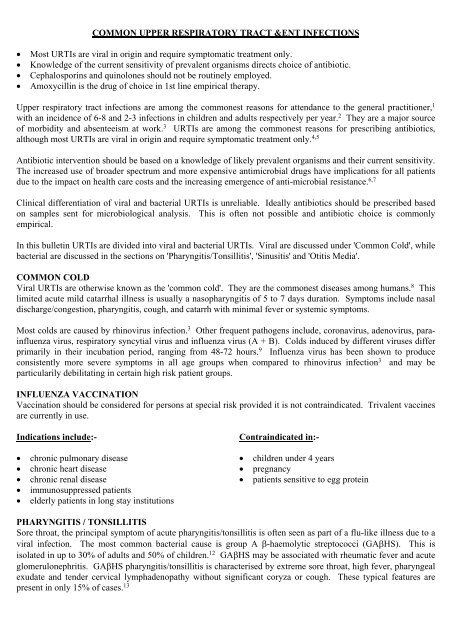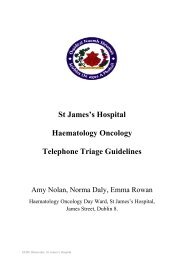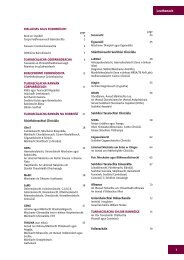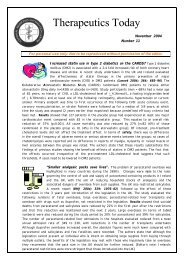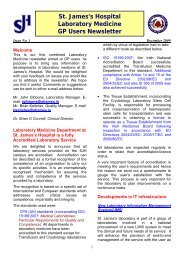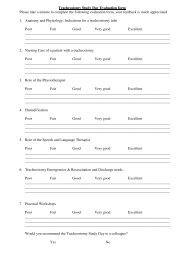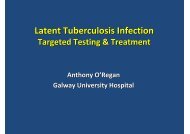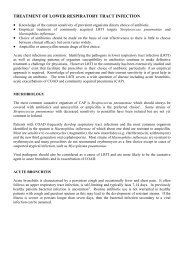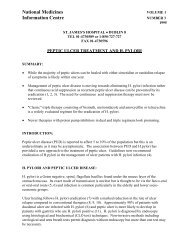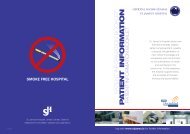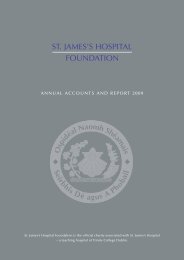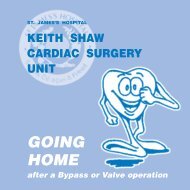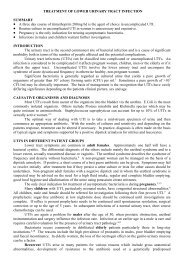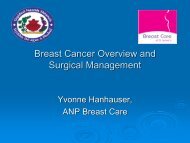COMMON UPPER RESPIRATORY TRACT &ENT; INFECTIONS ...
COMMON UPPER RESPIRATORY TRACT &ENT; INFECTIONS ...
COMMON UPPER RESPIRATORY TRACT &ENT; INFECTIONS ...
Create successful ePaper yourself
Turn your PDF publications into a flip-book with our unique Google optimized e-Paper software.
<strong>COMMON</strong> <strong>UPPER</strong> <strong>RESPIRATORY</strong> <strong>TRACT</strong> &<strong>ENT</strong> <strong>INFECTIONS</strong>• Most URTIs are viral in origin and require symptomatic treatment only.• Knowledge of the current sensitivity of prevalent organisms directs choice of antibiotic.• Cephalosporins and quinolones should not be routinely employed.• Amoxycillin is the drug of choice in 1st line empirical therapy.Upper respiratory tract infections are among the commonest reasons for attendance to the general practitioner, 1with an incidence of 6-8 and 2-3 infections in children and adults respectively per year. 2 They are a major sourceof morbidity and absenteeism at work. 3 URTIs are among the commonest reasons for prescribing antibiotics,although most URTIs are viral in origin and require symptomatic treatment only. 4,5Antibiotic intervention should be based on a knowledge of likely prevalent organisms and their current sensitivity.The increased use of broader spectrum and more expensive antimicrobial drugs have implications for all patientsdue to the impact on health care costs and the increasing emergence of anti-microbial resistance. 6,7Clinical differentiation of viral and bacterial URTIs is unreliable. Ideally antibiotics should be prescribed basedon samples sent for microbiological analysis. This is often not possible and antibiotic choice is commonlyempirical.In this bulletin URTIs are divided into viral and bacterial URTIs. Viral are discussed under 'Common Cold', whilebacterial are discussed in the sections on 'Pharyngitis/Tonsillitis', 'Sinusitis' and 'Otitis Media'.<strong>COMMON</strong> COLDViral URTIs are otherwise known as the 'common cold'. They are the commonest diseases among humans. 8 Thislimited acute mild catarrhal illness is usually a nasopharyngitis of 5 to 7 days duration. Symptoms include nasaldischarge/congestion, pharyngitis, cough, and catarrh with minimal fever or systemic symptoms.Most colds are caused by rhinovirus infection. 3 Other frequent pathogens include, coronavirus, adenovirus, parainfluenzavirus, respiratory syncytial virus and influenza virus (A + B). Colds induced by different viruses differprimarily in their incubation period, ranging from 48-72 hours. 9 Influenza virus has been shown to produceconsistently more severe symptoms in all age groups when compared to rhinovirus infection 3 and may beparticularily debilitating in certain high risk patient groups.INFLUENZA VACCINATIONVaccination should be considered for persons at special risk provided it is not contraindicated. Trivalent vaccinesare currently in use.Indications include:-• chronic pulmonary disease• chronic heart disease• chronic renal disease• immunosuppressed patients• elderly patients in long stay institutionsContraindicated in:-• children under 4 years• pregnancy• patients sensitive to egg proteinPHARYNGITIS / TONSILLITISSore throat, the principal symptom of acute pharyngitis/tonsillitis is often seen as part of a flu-like illness due to aviral infection. The most common bacterial cause is group A β-haemolytic streptococci (GAβHS). This isisolated in up to 30% of adults and 50% of children. 12 GAβHS may be associated with rheumatic fever and acuteglomerulonephritis. GAβHS pharyngitis/tonsillitis is characterised by extreme sore throat, high fever, pharyngealexudate and tender cervical lymphadenopathy without significant coryza or cough. These typical features arepresent in only 15% of cases. 13
Other pathogens isolated include strep. pneumonia, haemophilus influenza and staphylococcus aureus and areparticularly implicated in cases of recurrent tonsillitis.Other causes of acute exudative pharyngitis/tonsillitis include infectious mononucleosis especially in youngadults, and rarely gonococcal pharyngitis and diphtheria.A throat swab is the conventional laboratory test used to make a definitive diagnosis of streptococcal infection.Up to 80% of patients with a sore throat are treated with an antibiotic without laboratory investigation.SINUSITISSinusitis occurs in up to 5% of patients with a URTI. 14 The main symptoms include purulent rhinorrhoea (nasaldischarge), malaise, cough, fever, nasal obstruction (unilateral or alternating), impaired smell and facial pain. Itmay be difficult to distinguish from allergic rhinitis but this is suggested by watery rhinorrhoea, sneezing, nasalobstruction (bilateral) and nasal itch.The maxillary sinus is the most commonly affected and pain occurs over the cheek/upper teeth region. Thecommonest organisms isolated include, strep. pneumonia, H. influenza and M catarrhalis. 15 Other pathogensinclude strep. pyogenes and gram negative bacilli and anaerobes. Complications are rare but include orbitalabscess, meningitis, cerebral abscess and cavernous sinus thrombosis.OTITIS MEDIAAcute otitis media (AOM) is predominantly a disease of early childhood. Approximately 40% of children under10 years suffer from an episode. The incidence is highest in the first two years of life. Specific symptomsincluding earache (otalgia), fever and impairment of hearing, may be accompanied by non-specific symptomssuch as, nausea, vomiting, irritability, loss of appetite and lethargy. 16 Young children may pull at their ear or bangtheir heads. Ear pain is worsened by swallowing and is often markedly reduced with the onset of a discharge(present in 20% of children at presentation).On examination, the tympanie membrane appearance varies with the stage of infection. It initially showsincreased vascularity, becoming red and thickened with loss of landmarks, bulges and eventually perforatesresulting in a purulent discharge. 10 Bacterial infection accounts for the majority of cases with viruses responsiblefor the remainder. The most frequently isolated pathogens are strep. pneumonia and H. influenza. Additionalpathogens include, M. catarrhalis, strep. pyogenes, staph aureus, gram negative bacteria and anaerobes. 16CHOICE OF ANTIBIOTIC− Choice depends on the likely susceptibility of the organism, ease of administration, freedom from adverseeffects and relative cost.− An antibiotic that has a short simple dosing regimen and is convenient to administer and acceptable to thepatient (especially if a child), will improve compliance and thus more reliably resolve infection.− The longer the regimen after resolution of symptoms the more likely non-compliance becomes.− Poor compliance has been identified as the most frequent cause of antibiotic treatment failures.PENICILLINS− Amoxycillin remains the antibiotic of 1st choice. 22,23,24 It is active against strep pneumonia and most strains ofhaemophilus influenza.− Ampicillin is similar in efficacy to amoxycillin but its GI absorption is less than 50% and is further decreasedby food.− Phenoxy methyl penicillin (Penicillin V) is less active than amoxycillin or ampicillin, but has been used as 1stline treatment in streptococcal pharyngitis.− Co-amoxyclav (amoxycillin/clavulanic acid) should be reserved for infections which are likely to be β-lactamase producing.− Side effects of penicillins include nausea, diarrhoea and hypersensitivity reactions.
CEPHALOSPORINS− Divided into three groups based on their increasing gram negative activity:-1st Generation: Not suitable for URTI due to poor activity against haemophilus influenza and moraxellacatarrhalis. 252nd Generation: Cefaclor and cefuroxime axetil have enhanced activity against haemophilus influenza andmoraxella catarrhalis. The activity of cefuroxime is in most cases greater than cefaclor. 26 Its Bioavailabilityis increased if taken with food.3rd Generation: This group currently includes cefixime and cefpodoxime proxetil. They are even lesssusceptible to inactivation by β-lactamases and have greater activity against these gram negative bacteria. 27,2810-16% of patients allergic to penicillins are also allergic to cephalosporins. 28 Patients who experienceimmediate hypersensitivity reactions to penicillins should not be given a cephalosporin. In general the neworal broad spectrum cephalosporins offer no clear advantage over previously available drugs and are far moreexpensive and should be used as 2nd line agents only.MACROLIDESErythromycin:Suitable for use in patients allergic to penicillins. It is active against β-lactamase producing organisms.Disadvantages include poor oral bioavailability, gastrointestinal side effects and 'intermediate' activity againsthaemophilus influenza. 29The newer macrolides, azithromycin and clarithromycin are more effective than erythromycin against streppneumonia, haemophilus influenza and moraxella catarrhalis. They have greater bioavailability thanerythromycin, 27 fewer gastrointestinal side effects 30,31 and azithromycin has the benefit of a short treatment course(3 days). However, they are more expensive and should be used as 2nd line agents.Quinolones:Ciprofloxacin and ofloxacin have good activity against haemophilus influenza and moraxella catarrhalis but pooractivity against strep. pneumoniae. They should be reserved as 2nd or 3rd line treatment where few alternativesexist and there is a differential benefit in terms of efficacy, safety or cost.TREATM<strong>ENT</strong>− Treatment is aimed at relieving pain, eradicating infection, preventing complications while avoidingunnecessary antibiotic therapy.− Broad spectrum antibiotics are usually indicated in acute sinusitis. Acute sinusitis usually resolves withinthree weeks.− Acute otitis media resolves spontaneously without antibiotic therapy in approximately 70-80% of cases within72 hours. 17 There are conflicting studies both supporting and refuting improved recovery rates and decreasedcomplication rates in patients receiving antibiotics compared to those on no treatment. 18,19,20 Antibiotics arecurrently widely accepted as the mainstay of treatment.DURATION OF TREATM<strong>ENT</strong>− The optimal duration of antibiotic treatment (5 - 14 days) remains controversial.− Shorter courses may be effective especially where compliance is a problem.ANTIBIOTIC RESISTANCE− Rates of antimicrobial resistance to ampicillin/amoxycillin have been increasing in bacteria responsible forcommunity acquired respiratory tract infections, e.g. M. catarrhais, H. influenza and Strep. pneumonia− The unnecessary use of antibiotics, in particular, broad spectrum β-lactamase stable antibiotics are more likelyto lead to the emergence of resistant strains mainly by gram negative pathogens.IMPORTANT DRUG INTERACTIONS
A number of the newer antimicrobials may inhibit drug metabolism 33 and broad spectrum antibiotics may reducethe contraceptive efficacy of the combined oral contraceptive pill 33 .COST5 Days 10 DaysAmpicillin 250mg QID £1.16 £2.33Amoxycillin 250mg TID £2.24 £4.49Amoxil 250mg TID £2.63 £5.26Penicillin V (Calvepen 333) 33mg TID £0.58 £1.16Co-amoxyclav (Augmentin) 375mg TID £6.24 £12.47Ofloxacin (Tarivid) 200mg BD £7.95 £15.90Ciprofloxacin (Ciproxin) 250mg BD £8.06 £16.12Cefaclor (Distaclor LA) 375mg BD £4.95 £9.90Cefaclor (Distaclor Caps). 250mg TID £7.51 £15.03Cefixime (Suprax) 200mg Daily £7.54 £15.07Cefpodoxime (Cefodox) 100mg BD £8.82 £17.64Cefuroxime (Zinnat) 250mg BD £9.66 £19.31Erythromycin B.P. 250mg QID £1.00 £2.00Erythromycin Stearate 250mg QID £2.59 £5.19Clarithromycin (Klacid) 250mg BD £9.88 £19.76Azithromycin (Zithromax) 250mg BD £14.95 for 3 days- Price quoted is cost price (G.M.S. 1996)- Dose quoted is adult dosageREFERENCES1. Fam Pract, 1995 Jun; 12 (2): 166-70.2. J Allerg Clin Immunol, 1992 Sep; 90 (3 pt 2): 433-6.3. Am J Med, 1995 Dec 29; 99 (6B): 24s-27s.4. Am Fam Physician, 1991 Nov: 44 (5 Suppl): 33s-40s.5. J Fam Pract, 1996 Apr; 42 (4): 357-61.6. J Antimicrobial-Chemother, 1990 Dec; 26 (Suppl E):53-61.7. JAMA, 1995; 273: 214-219.8. Semin Respir Infect, 1995 Mar; 10 (1): 3-13.9. Epidermiol Infect, 1993 Aug; 111 (1): 143-156.10. Drugs Aging, 1995 May; 6 95): 368-87.11. Drugs Aging, 1994 Jul; 5 (1): 18 -19.12. Fam Pract, 1992; 9: 255-62.13. Am Fam Physician, 1994; 49: 1147-54.14. Practitioner, Jan 1996; 240: 54-57.15. New Ethicals, 1994: 31: 31-34.16. MeReC Bulletin, March 1993; Vol 4; No3.17. Can Fam Physician, 1993; 39: 2157-62.18. BMJ, 1991; 303: 558-562.19. BMJ, 1991; 303: 1450-1452.20. BMJ, 1985; 290: 1033-1037.21. Am J Med, 1995 Dec; (Suppl 6B): 3s-6s.22. Pediatric Clin North Am, 1995 Jun; 42 (3): 509-17.23. J Pediatrics, 1991 Sep; 119: 495-500.24. Pediatrics, 1991 Apr; 87: 466-474.25. The Practitioner, 1991; 235: 958-960.26. DICP Ann P'cotherapy, 1990; 24: 45-51.27. Drugs, 1991; 42 (Suppl 3): 25-33.28 Am J Med Sci, 1992; 303 (1): 35-39.29. Antibiotics & Chemotherapy 6th Edition, Lambert &O'Grady, 1992: 355-369.30. Pharmacotherapy, 1992; 12 (3): 161-73.31. Prescriber, 1992; 12 (3): 161-73.32. N Eng J Med, 1991; 324 (6): 384-394.33. NMIC Bulletin, 1996; 2 (2): 3.


